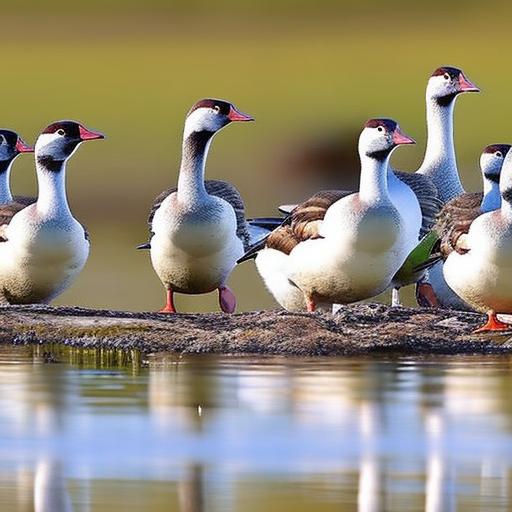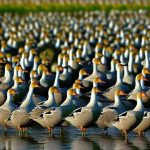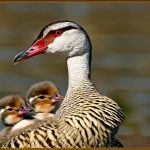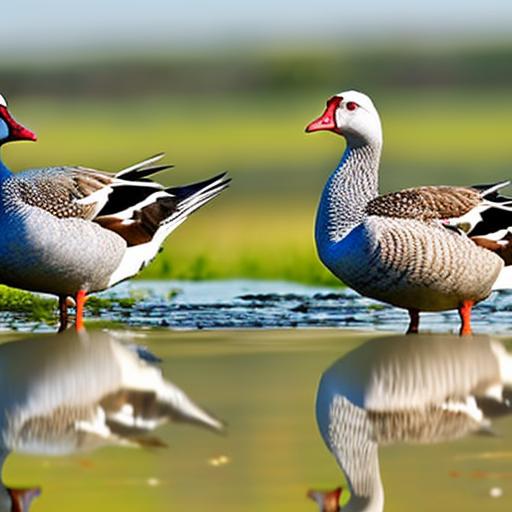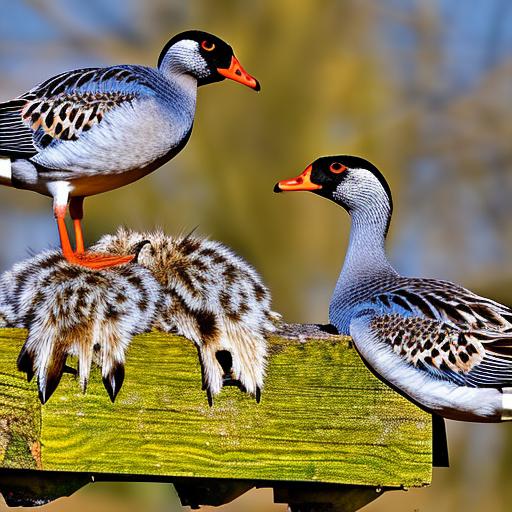The breeding season for geese typically occurs in the spring, with the exact timing varying depending on the species and geographic location. During this time, geese engage in courtship rituals, mate selection, and nest building in preparation for laying and hatching eggs. Understanding the breeding season is crucial for wildlife managers, conservationists, and researchers to effectively monitor and protect goose populations.
The breeding season is a critical period in the life cycle of geese, as it directly impacts population dynamics and overall reproductive success. Geese are known for their strong pair bonds, with mated pairs often returning to the same breeding grounds year after year. This fidelity to breeding sites highlights the importance of understanding the breeding season to ensure the conservation and protection of these vital habitats. Additionally, studying the breeding season provides valuable insights into the behavior, ecology, and population trends of geese, which can inform management strategies and conservation efforts.
Geese Behavior During Breeding Season
During the breeding season, geese exhibit a range of behaviors that are essential for successful reproduction. Mated pairs engage in courtship displays, which can include vocalizations, head bobbing, and elaborate movements to strengthen their bond and establish their territory. Once a pair has formed, they will begin to search for a suitable nesting site, often in close proximity to water for easy access to food and protection from predators.
Nesting behavior is another key aspect of geese behavior during the breeding season. Female geese will construct nests using a variety of materials, such as grass, twigs, and feathers, to create a secure and comfortable environment for laying and incubating eggs. Males will often stand guard nearby, alerting their mate to potential threats and defending the nesting area from intruders. Understanding these behaviors is crucial for wildlife managers and researchers to monitor breeding populations and implement conservation measures to protect nesting sites from disturbance and habitat loss.
Environmental Factors Impacting Breeding
Environmental factors play a significant role in influencing the breeding success of geese. Access to suitable nesting sites with ample food resources and protection from predators is essential for ensuring the survival of both adults and their offspring. Changes in habitat quality, such as wetland degradation, urban development, and agricultural intensification, can negatively impact breeding populations by reducing available nesting sites and food sources.
Climate variability also poses a threat to breeding geese, as extreme weather events, such as droughts or floods, can disrupt nesting activities and reduce reproductive success. Additionally, environmental pollution, such as water contamination and pesticide exposure, can have detrimental effects on the health and viability of goose eggs and goslings. Understanding these environmental factors is crucial for implementing conservation measures to mitigate their impact on breeding populations and ensure the long-term sustainability of goose populations.
Breeding Season Management
Effective management of the breeding season is essential for maintaining healthy and sustainable goose populations. Wildlife managers and conservationists can implement a range of strategies to support breeding geese, including habitat restoration, predator control, and public education initiatives. Restoring and protecting wetland habitats is crucial for providing suitable nesting sites and food resources for breeding geese, while predator control measures can help reduce nest predation and increase reproductive success.
Public education and outreach programs can also play a key role in promoting awareness and understanding of the importance of breeding season management for goose populations. By engaging with local communities and stakeholders, conservation organizations can foster support for conservation efforts and encourage responsible stewardship of natural habitats. Additionally, monitoring breeding populations through surveys and research can provide valuable data to inform management decisions and assess the effectiveness of conservation measures.
Nesting and Egg-Laying
Nesting and egg-laying are critical stages in the breeding season for geese, as they directly impact reproductive success and population dynamics. Female geese will typically lay a clutch of eggs ranging from 3 to 12, depending on the species, with each egg being carefully incubated for several weeks before hatching. Nesting sites are carefully selected by females to provide protection from predators and easy access to food sources, such as aquatic plants and insects.
Egg-laying behavior is influenced by a range of environmental factors, including habitat quality, food availability, and predator presence. Female geese will often lay one egg per day until their clutch is complete, carefully arranging them in the nest to ensure proper incubation. Males will stand guard nearby, alerting their mate to potential threats and defending the nesting area from intruders. Understanding these behaviors is crucial for wildlife managers and researchers to monitor breeding populations and implement conservation measures to protect nesting sites from disturbance and habitat loss.
Hatching and Rearing Goslings
Hatching and rearing goslings is a critical stage in the breeding season for geese, as it directly impacts population dynamics and overall reproductive success. After an incubation period of approximately 25-30 days, goslings will begin to hatch from their eggs, relying on their parents for warmth, protection, and guidance. Once hatched, goslings are precocial, meaning they are able to walk, swim, and feed themselves shortly after birth.
Parental care is essential for the survival of goslings during the early stages of life, as they are vulnerable to predation and environmental hazards. Both male and female geese play a role in rearing their offspring, guiding them to suitable feeding areas and providing protection from predators. Understanding the hatching and rearing process is crucial for wildlife managers and researchers to monitor breeding populations and implement conservation measures to protect goslings from disturbance and habitat loss.
Conservation and Protection Efforts for Breeding Geese
Conservation and protection efforts are essential for ensuring the long-term sustainability of breeding geese populations. Habitat restoration projects can help provide suitable nesting sites and food resources for breeding geese, while predator control measures can help reduce nest predation and increase reproductive success. Additionally, public education initiatives can promote awareness of the importance of breeding season management for goose populations.
Conservation organizations play a key role in advocating for policies and regulations that support the protection of breeding geese and their habitats. By engaging with local communities and stakeholders, conservation organizations can foster support for conservation efforts and encourage responsible stewardship of natural habitats. Monitoring breeding populations through surveys and research can provide valuable data to inform management decisions and assess the effectiveness of conservation measures. Overall, conservation and protection efforts are crucial for maintaining healthy and sustainable goose populations for future generations to enjoy.
Meet Walter, the feathered-friend fanatic of Florida! Nestled in the sunshine state, Walter struts through life with his feathered companions, clucking his way to happiness. With a coop that’s fancier than a five-star hotel, he’s the Don Juan of the chicken world. When he’s not teaching his hens to do the cha-cha, you’ll find him in a heated debate with his prized rooster, Sir Clucks-a-Lot. Walter’s poultry passion is no yolk; he’s the sunny-side-up guy you never knew you needed in your flock of friends!

